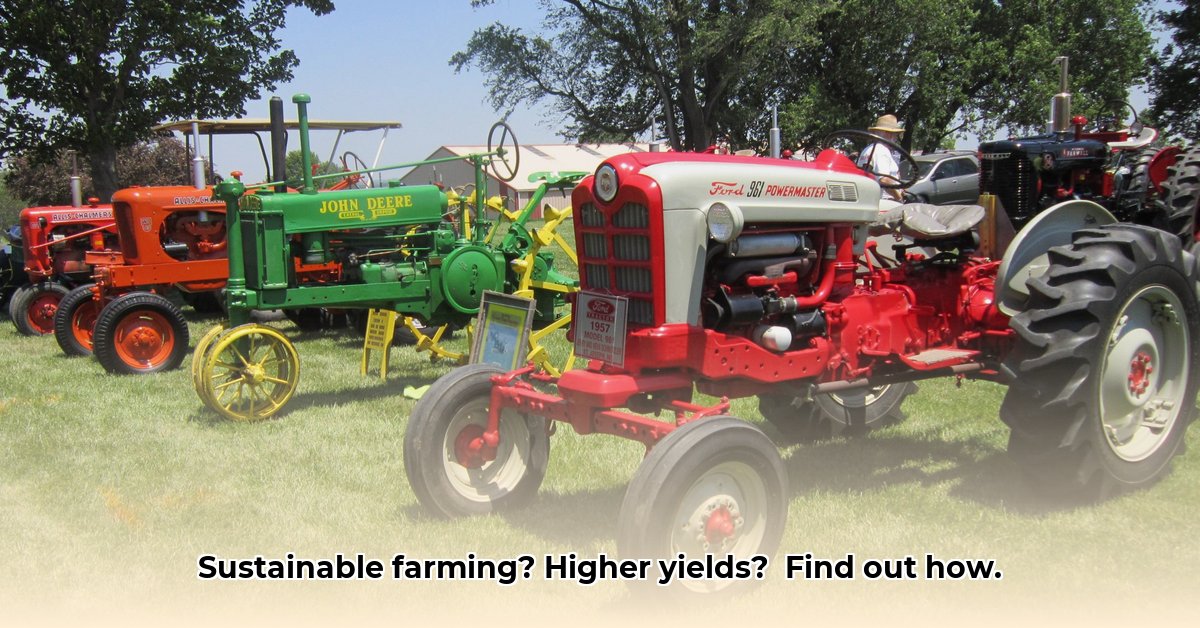
The dust has settled on the Alapahoochee Tractor Show, but the reverberations of its focus on sustainable farming innovations continue to resonate. This year's event wasn't just a display of gleaming new machinery; it was a dynamic forum exploring the crucial synergy between technological advancements and time-honored farming practices. The show served as a powerful reminder that progress in agriculture isn't about abandoning tradition, but rather building upon it strategically. This year's event highlighted a compelling blend of old and new, a testament to the enduring value of both established methods and emergent technologies. For more on sustainable farming techniques, check out this helpful resource: sustainable farming guide.
Precision Agriculture: Farming with a Tech-Savvy Touch
Gone are the days of the lone farmer working the land in isolation. Modern sustainable agriculture is increasingly reliant on technology, a fact clearly on display at the Alapahoochee Tractor Show. Imagine soil sensors constantly monitoring moisture levels and transmitting data directly to a farmer's smartphone in real-time. Envision drones meticulously applying fertilizer only where needed, minimizing waste. Picture sophisticated software analyzing this wealth of data to optimize irrigation schedules, significantly reducing water consumption. This is precision agriculture—and it's revolutionizing the farming landscape.
This precise approach promises significant increases in yield by maximizing resource efficiency. Reduced fertilizer and water usage translates directly to a smaller environmental footprint, benefiting everyone. However, the show also revealed some challenges. The substantial initial investment needed for this technology is a significant hurdle for many farmers, raising concerns about equitable access. Furthermore, concerns about over-reliance on technology and the potential for malfunctions were voiced by some seasoned agriculturalists. The discussions underscored that seamlessly integrating these advancements requires meticulous planning and thoughtful consideration. Isn't it remarkable how technology and time-tested knowledge can work in tandem?
Traditional Wisdom: The Unsung Heroes of Sustainable Farming
The Alapahoochee Tractor Show wasn't solely a celebration of cutting-edge technology; it was also a resounding tribute to the enduring value of traditional farming practices. These methods, often passed down through generations, reflect a profound understanding of the land and its intricate ecological balance. Crop rotation, cover cropping, and integrated pest management are not mere buzzwords; they represent proven strategies for building healthier soil, enhancing biodiversity, and minimizing reliance on chemical inputs.
Many attendees strongly advocated for the crucial role of these traditional techniques in long-term sustainability, emphasizing their holistic approach that works with nature, rather than against it. While proponents agreed that precision agriculture could complement these methods, concerns were raised about the potential negative consequences of hastily adopting new technologies without a thorough understanding of the fundamental principles underlying traditional methods. The core message wasn’t about choosing one approach over the other; it was about finding the optimal balance between innovation and deeply ingrained experience. How can we best leverage both to maximize our results?
Bridging the Gap: Challenges and Opportunities
A critical theme recurring throughout the Alapahoochee Tractor Show was the issue of access. The transition to sustainable agriculture, whether through new technologies or a revitalization of traditional practices, often necessitates substantial financial investment. Farmers require access to affordable technologies, credit, and supportive political frameworks to successfully make this transition. While the show showcased various programs aimed at bridging this funding gap, a sense of urgency pervaded the discussions, underscoring the need for more comprehensive solutions.
Another key discussion focused on market accessibility. Sustainable farming often entails higher production costs, potentially impacting competitiveness in the marketplace. Farmers need guaranteed markets that fairly compensate them for their commitment to sustainable practices. This isn't merely an issue for individual farmers; it's about the creation of a food system that values and rewards sustainable agriculture and those working diligently to practice it. How can we ensure fair compensation for farmers adopting sustainable practices?
A Collaborative Journey: Working Together for a Sustainable Future
The overarching message emanating from the Alapahoochee Tractor Show was clear: sustainable agriculture is a collaborative endeavor. It's not just about farmers; it involves investors providing access to affordable technologies and credit, policymakers creating supportive policies and incentives, and consumers actively supporting sustainable practices through their purchasing choices.
We need a system where all stakeholders recognize and fulfill their roles collaboratively. It's a journey that demands compromises, shifts in perspective, and adaptation of technologies and practices to suit local contexts. It’s not a race, but a continuous learning process requiring ongoing refinement.
Actionable Steps: Making a Difference
The Alapahoochee Tractor Show provided several actionable steps individuals and institutions can take to support sustainable agriculture:
Farmers:
- Explore cost-effective precision agriculture tools and techniques. (e.g., government subsidies, leasing options)
- Seek out local training and educational opportunities. (e.g., workshops, online courses)
- Prioritize soil health and biodiversity. (e.g., cover cropping, crop rotation)
- Explore diverse income streams. (e.g., agritourism, farmers' markets)
Investors:
- Develop targeted financial products for sustainable agriculture. (e.g., impact investing funds)
- Invest in research and development of climate-resilient technologies. (e.g., drought-resistant crops)
Policymakers:
- Offer financial incentives and educational resources. (e.g., tax breaks, grants)
- Invest in infrastructural support. (e.g., improved transportation, storage facilities)
- Advocate for policies promoting sustainable agriculture. (e.g., sustainable food procurement policies)
Consumers:
- Support local and sustainable farms. (e.g., farmers' markets, CSAs)
- Demand transparency in food production, knowing the origin and growing methods of your food.
The Alapahoochee Tractor Show showcased the promise and challenges of sustainable agriculture, underscoring that a balanced approach, tailored to individual farms and communities, is key to creating a future where both the environment and the economy thrive.